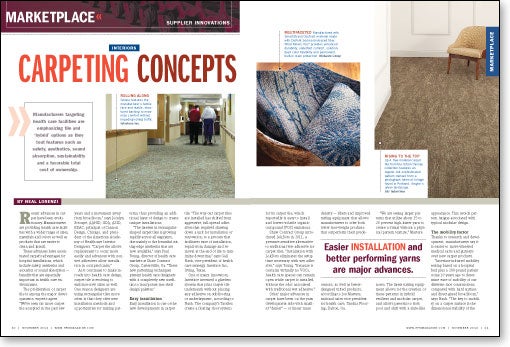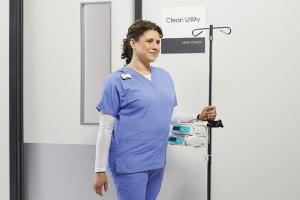Carpeting concepts

Recent advances in carpet have been evolutionary. Manufacturers are providing health care facilities with a wider range of sizes, materials and colors as well as products that are easier to clean and install.
These advances have accentuated carpet's advantages for hospital installations, which include safety, aesthetics and acoustics or sound absorption — benefits that are especially important in health care environments.
The proliferation of carpet tile is among the major developments, experts agree. "We've seen far more carpet tile accepted in the past few years and a movement away from broadloom," says Jocelyn Stroupe, AAHID, IIDA, ASID, EDAC, principal of Cannon Design, Chicago, and president of the American Academy of Healthcare Interior Designers. "Carpet tile allows replacement to occur more easily and advances with non-wet adhesives allow installation in occupied units."
As it continues to make in-roads into health care design, carpet tile is evolving to embrace new sizes as well. One reason designers are using rectangular tiles more often is that they offer new installation methods and opportunities for mixing patterns, thus providing an additional layer of design to create unique installations.
"The interest in rectangular-shaped carpet tiles is growing rapidly across all segments, due mainly to the beautiful cutting-edge aesthetics that are now available," says Paul Young, director of health care markets at Shaw Contract Group, Cartersville, Ga. "These new patterning techniques present health care designers with a completely new medium to incorporate into their design palettes."
Easy installation
Easy installation is one of the new developments in carpet tile. "The way our carpet tiles are installed has shifted from aggressive, full-spread adhesives that required shutting down a unit for installation or renovation, to a process that facilitates ease of installation, repair from damage and removal at the end of life to minimize downtime," says Gail Nash, vice president of health care strategy, Interface Inc., Irving, Texas.
One of many innovators, Interface invented a glueless system that joins carpet tile underneath without placing any adhesive on subflooring or underlayment, according to Nash. The company's Tactiles create a floating floor system for its carpet tile, which reportedly is easy to install and lowers volatile organic compound (VOC) emissions.
Shaw Contract Group introduced LokDots in 2011, a pressure-sensitive alternative to traditional wet adhesive for carpet tiles. "Installation with LokDots eliminates the setup time necessary with wet adhesive," says Young. "Because it contains virtually no VOCs, health care spaces can remain open while carpet is installed, without the odor associated with traditional wet adhesive."
Other major advances in carpet have been on the yarn development side with smaller "denier" — or linear mass density — fibers and improved tufting equipment that allows manufacturers to offer both lower face-weight products that outperform their predecessors, as well as better-designed tufted products, according to Joe Martere, national sales vice president for health care, Tandus Flooring, Dalton, Ga.
"We are seeing larger patterns that utilize about 15 to 20 percent high-luster yarn to create a visual without a physical pattern texture," Martere notes. The latest tufting equipment allows for the creation of these patterns in hybrid resilient and modular carpet, and allows patterns to flow, pool and shift with a slate-like appearance. This avoids pattern fatigue associated with typical modular design.
The mobility factor
Thanks to research and development, manufacturers say it is easier to move wheeled medical carts and gurneys over new carpet products.
"Interface initiated mobility testing based on a hospital bed plus a 200-pound patient some 10 years ago to determine ease of mobility of our different face constructions compared with hard surface and direct-glued broadloom," says Nash. "The key to mobility on a carpet surface is the dimensional stability of the backing plus the density and height of the face construction. As we develop new tufting technologies and increase the level of recycled, post-consumer backing and nylon face, we continue to test mobility and performance levels."
Research suggests that carpet construction with high density; a face weight of 18 to 24 ounces per square yard; a level-loop, non-sculpted construction; and a non-cushioned performance backing functions best in health care settings, according to Lauri Watnee, director of health care and education at the Mohawk Group, Calhoun, Ga. "In addition, increasing the wheelbase on carts and gurneys from 5.25 inches to 8 inches provides a 30 to 40 percent reduction in the roller resistance."
Clean and green
Cleaning of carpet surfaces also has come a long way. Manufacturers now offer equipment that is smaller, quieter and more efficient. Hot water extraction today requires a minimum of two hours of dry time. Spot cleaners speed up the process, thus saving time and money.
The Mohawk Group recently introduced SmartStrand Contract material, a bio-based fiber system made with Dupont Sorona, which contains 37 percent renewably sourced polymer. Lifetime stain resistance reportedly is built into the carpet fiber and 95 percent of spills easily clean with water.
"This is a big advantage in hospitals, as maintenance requires fewer chemical cleaners," says Watnee. "Also, the material is resistant to discoloration and degradation from chemicals typically found in health care environments."
According to Stroupe, most carpet manufacturers also have been proactive in the use of low-VOC products and recycled content fibers and backing to create green products.
"The hot button in health care today is the concern over potentially toxic chemicals and the shift toward complete transparency of a product's overall environmental impact," says Holly DeBrodt, LEED AP, director of sustainability at Bentley Prince Street, City of Industry, Calif. "In the last few years, we've seen a proliferation of restricted substances lists and materials red lists. More health care customers are consulting these lists when making decisions based on health and safety factors for their projects."
Ashleigh Pfluger, LEED AP, AAHID, partner and interior designer at TJNG Partners, Maitland, Fla., agrees that environmental issues are a sigÂnificant factor in the selection of carpet.
"We select carpet with the smallest environmental footprint we can and still meet the tough performance criteria of the hospital environment," she says. "This is a practice we've had for awhile, but just in the last couple of years it is becoming more important to our clients."
Expanding influence
The use of carpet is expanding into more noncritical areas of hospitals, experts agree. Carpet has been used in computer rooms, elevators, offices, conference rooms, pharmacies and waiting areas for years.
"However, a growing appreciation of the multi-attribute value of carpet is moving it into corridors in patient care areas, diagnostic imaging suites, dry physical therapy areas, exam and procedure rooms, nursing stations and patient rooms," says Keith Gray, director of product innovation at J+J/Invision, Dalton, Ga.
While traditional broadloom carpet has been losing floor space in acute care facilities, modular carpet and "hybrid" options continue to be used, according to Martere. Because of their unique construction, hybrid products specifically are engineered for use in such patient areas as hospital corridors, waiting rooms and nurse stations.
"These products offer the key attributes of carpet while providing an impermeable backing system and chemically welded seams to improve moisture control and cleanability," he says. "They also offer an installation method that utilizes a peel-and-stick, non-wet adhesive system that is virtually odorless and allows for immediate occupancy."
When selecting carpet, facilities managers should consider the impact of life-cycle costs, particularly since their operational costs are being reduced, experts agree.
"It's important to look at the life-cycle cost of a product to determine what the true cost will be when the replacement and maintenance costs are factored in," says Watnee. "The longer a product remains installed on the floor and the fewer chemicals are required to maintain the appearance, whether for cleaning or as finish coat, the lower the overall cost will be."
Parsing the evidence
The drivers for carpet performance innovations in health care facilities today include regulatory pressure, customer satisfaction and the movement toward evidence-based design, according to experts.
For the past several years, health care design increasingly has emphasized decisions about the built environment based on research to assure the best possible outcomes for patients, caregivers and the hospital.
"In a growing number of instances, carpet innovations are less product-focused and more specification-focused, beginning with a technical appraisal of how carpet actually performs in health care facilities, especially in near-patient or clinical spaces," says Gray. "The innovation arises from applying this data to develop carpet specifications appropriate for health care applications." Until recently, he adds, little accurate technical information was available about how carpet performed in health care facilities, especially as it relates to underfoot cushioning, injury prevention, infection control and mobility.
"Sophisticated mechanical analysis of carpet, a relatively new science, shows, for example, that certain types of carpet without cushioned underlayment are anti-fatigue surfaces, challenging the conventional wisdom that 'softer is better,'" he explains. "Therefore, when non-cushioned, anti-fatigue carpet is specified, challenges to walking and rolling mobility associated with soft, compliant cushions are eliminated, while still delivering anti-fatigue performance."
Neal Lorenzi is a freelance writer based in Mundelein, Ill.
| Sidebar - For more information |
| For further details on the carpet products featured in this month's "Marketplace" article, readers can contact the following vendors: Bentley Prince Street Interface Inc. J+J/Invision Mohawk Group Shaw Contract Group Tandus Flooring |




